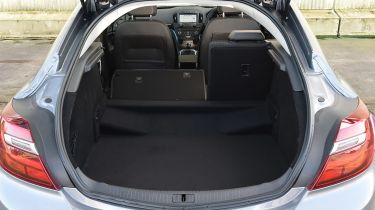Used Vauxhall Insignia (Mk1, 2008-2017) review - How practical is it?
A large boot and plenty of room for passengers make the Insignia a highly practical choice
In this competitive market, the Vauxhall Insignia has traditionally been one of the most practical cars, offering generous room for people and luggage. That’s still the case, and although more modern rivals now offer more space, the car remains a comfortable choice for five passengers.
Dimensions and cabin design
At 4,842mm long and 1,856mm wide, the Insignia has always been among the largest cars in its class, although its contemporary rivals were even bigger. For example, the Ford Mondeo was slightly longer than the Vauxhall (at 4,871mm), as was the Skoda Superb (4,861mm), although the Volkswagen Passat was rather smaller (4,767mm long and 1,832mm wide).
Given its large dimensions, it’s no surprise that the Vauxhall Insignia comfortably accommodates five adults. However, its sweeping roofline means that taller rear seat passengers may find their heads brushing the rooflining. That's not a problem on the estate model, though. And on our preferred model – the Insignia SRi Nav 1.6CDTi 136PS – electric seat adjustment for the front passenger is an optional extra.
Boot space
On hatchback models, there’s 530 litres of boot space with all seats in place. When the 60:40 split-folding rear seats are lowered, this expands to 1,470 litres. Yet while these figures are generous, they can’t quite match the biggest rivals; for example, the huge Skoda Superb has luggage capacities of 625 and 1,760 litres respectively.
The boot of the Insignia has a narrow opening, although the floor area is a usefully squarer shape than in some of its rivals. In the Vauxhall there’s also an awkward step in the load floor, but this is no different to the Mondeo; the difference is that you don’t have to flip the seat bases up to achieve a full-length platform in the Ford.
Vauxhall has been generous with the storage space inside the Insignia, giving it plenty of cubbies, a lidded compartment between the front seats and a large glovebox.
Equipment and technology
Like its Ford Mondeo, Skoda Superb and Volkswagen Passat rivals, the big Vauxhall is a firm favourite with fleet buyers, and Insignias are a common sight trawling the UK’s motorway network.
Compared to the Mondeo, which can appear bulky, the Insignia is one of the better-looking large cars out there, thanks to an arching roofline that tapers to a shallow rear screen and a raised tail.
What’s more, Vauxhall’s 2013 facelift improved on the original Insignia’s sharp design by adding a larger grille and revised LED headlights. Higher-spec cars also get a reprofiled chin spoiler with foglights, and the hatchback model’s tail-lights are joined by a thicker chrome bar across the tailgate. In fact, from some angles the Vauxhall Insignia is reminiscent of the Volkswagen CC.
The interior changes introduced in 2013 are equally subtle. The steering wheel is the same as the one fitted across the rest of the Vauxhall range and the curvy dashboard found on the first-generation Insignia is largely unchanged.
Vauxhall also reduced the number of buttons on the centre console, because all later Insignias get a touchscreen to navigate through the major functions.
Opt for a model equipped with sat-nav, and you also get a touchpad that’s used to work through the menus and write characters. This IntelliLink system features Apple CarPlay connectivity, so you can hook up your smartphone to access in-car entertainment apps for things like music and news. You can also use audio streaming, have text messages read aloud and play videos. The navigation system can be displayed two or three-dimensionally, and can be controlled by voice command.
All versions of the Insignia feature a digital radio as standard, with steering wheel-mounted controls. A Bose Premium sound system was optional, providing excellent clarity.
One of the most appealing extras Vauxhall offered for the Insignia was the eight-inch TFT instrument cluster. It cost around £400, and replaced the traditional analogue dials with a large screen that can show a range of information, from speed and revs to economy and driving efficiency. The system looks and feels very modern thanks to its clear, colourful display.
New to the Insignia from summer 2015 was OnStar, which provides in-car Wi-Fi, notifies the emergency services if the airbags are deployed and also includes a direct connection to call centre advisors. It was standard on Elite, Limited Edition and VXR trim levels, and a £395 option on other models.
Safety
The Insignia comes fitted with six airbags, ESP and two Isofix child seat mounts in the rear as standard. What's more, Euro NCAP awarded the car a score of 94 per cent for adult occupant protection in its independent crash tests, and gave it an overall rating of five stars.
However, it’s worth pointing out that the Insignia hasn’t been tested by Euro NCAP since 2009, so this doesn’t mean quite the same as a five-star rating achieved by an equivalent car in 2022.
A raft of advanced safety kit was available on the Vauxhall options list. This included a rear-view camera, plus a park-and-go technology pack with blind spot and rear traffic alerts.
Automatic lights and wipers could be added to lower-spec Insignias as extras, as could Vauxhall’s auto-park system and front and rear cameras. The front camera pack option includes lane-departure warning, adaptive cruise control and forward-collision alert. Optional OnStar also alerts the emergency services automatically if the airbag deploys.
While all this kit hiked the price, it kept the Insignia among the best cars in its class for safety equipment. Even so, modern rivals like the latest Ford Mondeo have definitely caught up in this regard, and offer tech such as city braking, which Vauxhall does not.







